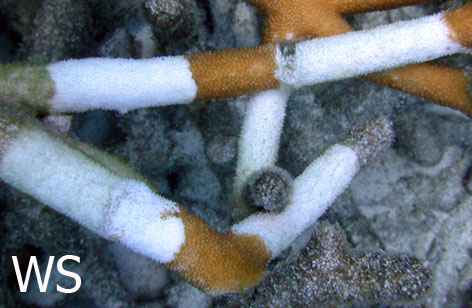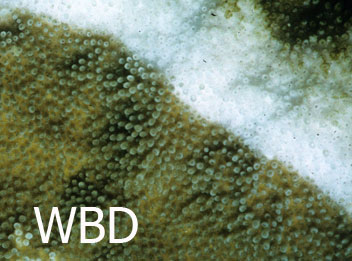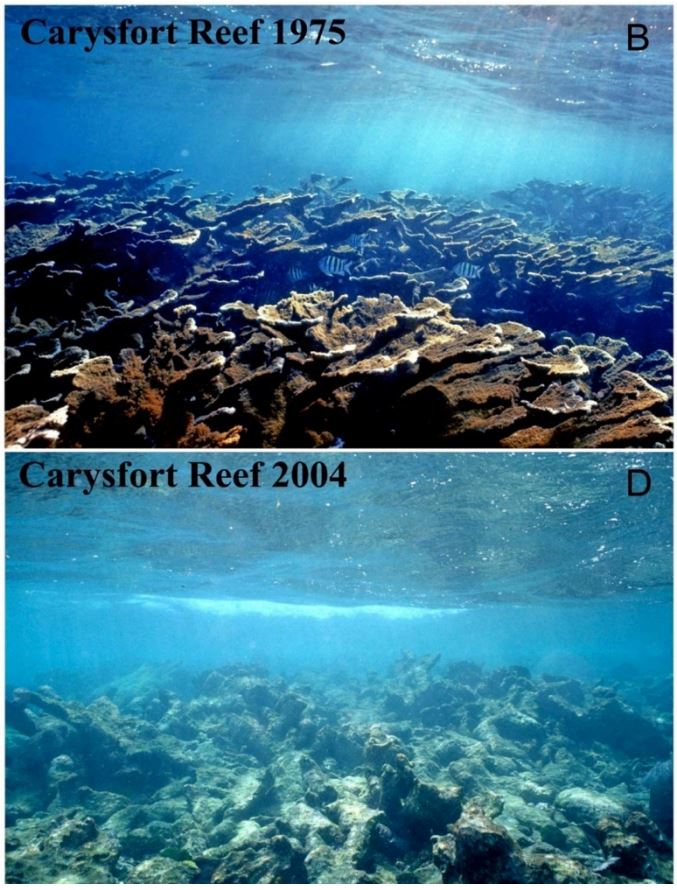White Band Disease
White Band Disease (WBD) is a common tissue loss disease that affects the two Caribbean acroporid species Acropora cervicornis and Acropora palmata throughout their geographic range. Since WBD was first described in the early 1970s, it has spread throughout the Wider Caribbean and caused wide-scale regional loss of these species, even contributing to near local extinctions in some areas and causing substantial restructuring of reef ecosystems in which they used to dominate.




Lesion Description
WBD lesions are characterized by a distinct band of bare skeleton immediately adjacent to intact, pigmented tissue. Exposed corallites where tissue recently receded remain intact and there is no other associated skeletal damage. The rate of tissue loss can range from as little as 1mm/ day to 3 cm/ day.
In some cases, an annular lesion may completely encircle a branch, or the lesion can appear as linear on one side.
Lesions usually begin at the basal portion of the branch or at the medial region where branches bifurcate and advance towards the apical branch tips.
The line of tissue loss is a sharp demarcation between intact tissue and the exposed skeleton. In White Band Type II, the line of tissue loss can be preceded by a margin of bleached tissue ranging from 1-10cm in width.
The margin of tissue loss is often smooth, however, fragments of tissue that have dissociated from the underlying skeleton may remain attached to adjacent tissue for several days.





Etiology
Transmission studies suggest that white band disease is caused by a communicable agent, however, a specific pathogen has not yet been definitively identified. While bacterial aggregates have been observed within diseased tissues, they are not consistently observed in the histology of WBD cases, and similar-looking aggregates have also been observed in colonies without lesions. Therefore, the precise etiology of white band disease is currently unknown.
Impact
Outbreaks of WBD in the 1970s and 1980s have caused extensive mortality of Acropora cervicornis and Acropora palmata throughout the Caribbean, with some reefs losing up to 90% of their populations. The loss of structure that these two species provided through their complex branching morphology transformed the landscape and ecology of reefs where these species historically dominated for thousands of years. Today, white band disease is still present throughout the Caribbean at lower background levels, and is the most common affliction to acroporid species aside from bleaching.

Relevant Publications about White Band Disease
Antonius, A. (1981). The “Band” Diseases in Coral Reefs, in Proceedings of the Fourth International Coral Reef Symposium, Vol. 2 (eds E. Gomez, C. Birkeland, R. Buddemeier, et al.). Marine Sciences Center, University fo the Philippines, Manila, Philippines, pp.7-14
Aronson, Richard & Precht, William. (2001). Aronson RB, Precht WF.. White-band disease and the changing face of Caribbean coral reefs. Hydrobiologia 460: 25-38. Hydrobiologia. 460. 25-38. 10.1023/A:1013103928980.
Bak, R. and Criens, S. (1982) Survival after Fragmentation of Colonies of Madracis mirabilis, Acropora palmata, and A. cervicornis (Scleractinia) and the Subsequent Impact of a Coral Disease, in Proceedings of the Fourth International Coral Reef Symposium, Vol. 2 (eds E. Gomez, C. Birkeland, R. Buddemeier, et al.). Marine Sciences Center, University of the Philippines, Manila, Philippines, pp. 221-227
Bruckner, A.W. (2003). Proceedings of the Caribbean Acropora Workshop : potential application of the U.S. Endangered Species Act as a conservation strategy, April 16-18, 2002, Miami, Florida.
Davis, M., Gladfelter, E., Lund, H., et al. (1986) Geographic Range and Research Plan for Monitoring White Band Disease. Biosphere Reserve Research Report No. 6, National Park Service, US Virgin Islands.
 Official websites use .gov
A .gov website belongs to an official government organization in the United States.
Official websites use .gov
A .gov website belongs to an official government organization in the United States. Secure .gov websites use HTTPS
A lock or https:// means you’ve safely connected to the .gov website. Share sensitive information only on official, secure websites.
Secure .gov websites use HTTPS
A lock or https:// means you’ve safely connected to the .gov website. Share sensitive information only on official, secure websites.